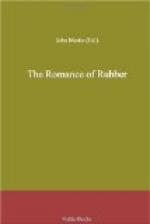Soon some Americans began to import raw rubber and to manufacture rubber goods of their own, and in the old world a Scotchman named Macintosh found a way of waterproofing cloth by spreading on it a thin coating of rubber dissolved in coal naphtha. Many people still refer to raincoats as mackintoshes. Rubber clothing shared favor with rubber shoes, but its popularity was short-lived for it did not wear well and was almost as sensitive to temperature as molasses and butter. The rubber shoes and coats get hard and stiff in winter and soft and sticky in summer. A man wearing a pair of rubber overalls who sat down too near a warm stove soon found that his overalls, his chair and himself were stuck fast together. The first rubber coats became so stiff in cold weather that when you took one off you could stand it up in the middle of the floor and leave it, for it would stand like a tent until the rubber thawed out, and when thawed it was almost as uncomfortable as is fly-paper to the fly.
One day Charles Goodyear, a Connecticut hardware merchant of an inventive turn of mind, went to a store to buy a life preserver. He could find only imperfect ones, but they drew his attention to the study of rubber, and presently he was thinking of it by day and dreaming of it by night. Rubber became a passion with him. He felt sure some way could be found to make it firm yet flexible regardless of temperature, and for ten years he experimented with different mixtures and processes, hoping to find the right one. So intent was he on his search that he found time for nothing else. Due to neglect his business went to pieces and he became very poor.
Finally, in 1839, when he was on the point of giving up in despair, he accidentally came upon the solution. He was experimenting in his kitchen, a place which, through lack of funds, he was often forced to use as a laboratory. Part of a mixture of rubber, sulphur and other chemicals, with which he was working, happened to drop on the top of the stove. It lay there sizzling and charring until the odor of the burning rubber called his attention to it. As he stooped to scrape it off the stove he gave a start of wonder as he noted that a change had come over the rubber during its brief contact with the stove.
To his surprise the mixture had not melted, but had flattened out in the shape of a silver dollar. When it had cooled enough to be handled, he found that it bent and stretched easily, without cracking or breaking, and that it always snapped back to its original shape. Strangest of all, it was no longer sticky. Apparently half the problem was solved. Whether his new mixture would stand the cold he had yet to find out, so he nailed it on the outside of the door and went to bed. Probably he slept but little and was up early. At any rate he found the rubber unaffected by the cold.




